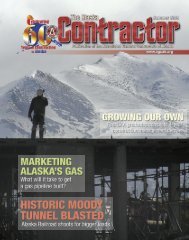The Alaska Contractor: Fall 2006
The Alaska Contractor: Fall 2006
The Alaska Contractor: Fall 2006
Create successful ePaper yourself
Turn your PDF publications into a flip-book with our unique Google optimized e-Paper software.
Training is a hot topic nationally.<br />
AGC of <strong>Alaska</strong> was fortunate<br />
to host the annual Western<br />
AGC Chapters Training Directors’<br />
Conference Aug. 1-4.<br />
During the conference, Don Whyte,<br />
president of the National Center for<br />
Construction Education and Research,<br />
gave a presentation loaded with information<br />
about national training trends.<br />
He led off by citing a two-year<br />
old Brookings Insititution report that<br />
forecasts an unprecedented boom in<br />
residential and commercial development<br />
in the next 25 years. <strong>The</strong> report<br />
estimates that 60 million new housing<br />
units will be needed by 2030 to<br />
accommodate an expected 33 percent<br />
growth in U.S. population.<br />
Between growing demand and<br />
coming retirements, Whyte said the<br />
construction industry needs to recruit<br />
180,000 new workers a year and<br />
replace 95,000 retiring workers each<br />
year. Nearly 2.5 million workers are<br />
needed by 2014.<br />
Here are a few areas of projected<br />
growth:<br />
• Residential construction will<br />
grow by 11 percent.<br />
• Commercial construction will<br />
grow by 8.6 percent.<br />
• Industrial construction will grow<br />
by 22 percent.<br />
• Pipeline construction will increase<br />
by approximately 85 percent.<br />
• 2005 put-in-place construction<br />
was $1.12 trillion, with an estimated<br />
11 to 15 percent increase<br />
in <strong>2006</strong>.<br />
Whyte also provided information<br />
about the ongoing rebuilding efforts<br />
EDUCATION REPORT<br />
Industry needs<br />
2.5 million workers by 2014<br />
in the Gulf Coast after a series of disasters<br />
there last fall killed over 1,800<br />
people, destroyed seven major hospitals,<br />
and 350,000 homes, and closed<br />
131,000 businesses in Alabama, Louisiana,<br />
Mississippi, and Texas. Whyte<br />
said those three states will spend an<br />
estimated $335 billion rebuilding.<br />
It will take more than 1 billion<br />
worker hours to repair or rebuild the<br />
damage, including the removal of<br />
more than 60 million cubic yards of<br />
debris, he said.<br />
It could take as long as fi ve years to<br />
repair the 150 offshore oil rigs that were<br />
destroyed or signifi cantly damaged<br />
during the hurricanes, Whyte said.<br />
For all these reasons and the volume<br />
of work for the next several years<br />
on the Gulf Coast, it’s reasonable to<br />
think <strong>Alaska</strong> will be impacted by the<br />
shortage of skilled workers.<br />
Here are some predictions about<br />
workforce shortages:<br />
• “Artifi cial” wage escalation becomes<br />
long-term increase.<br />
• Increased job site accidents.<br />
• Higher overtime costs, bids, and<br />
budgets.<br />
By VICKI SCHNEIBEL<br />
Education Director<br />
• Contracts awarded only to companies<br />
that have the employees<br />
to complete the jobs.<br />
• More competitive job market.<br />
• And, missed schedules, lower<br />
productivity and work quality.<br />
Hispanic workforce needs<br />
Whyte said for many AGC chapters,<br />
language is an issue. Nationally, the<br />
Hispanic workforce is a source. Here<br />
are some of the issues (nationally):<br />
• Skilled workforce shortage<br />
elevated in 2005.<br />
• Dramatic industry growth<br />
predicted through 2030.<br />
• Population of potential new U.S.<br />
workers is fl at or shrinking.<br />
• Many contractors are depend<br />
on Hispanic workers.<br />
• Some industrial owners are<br />
relaxing “English only” rules.<br />
• Hispanic guest workers seen<br />
as part of the solution.<br />
• Population will grow three times<br />
faster than any other minority.<br />
• Education, experience, and<br />
competence levels are vague.<br />
• Work ethic is a plus.<br />
• Minimal resources for Hispanic<br />
workforce development.<br />
• More than half of Hispanic workers<br />
are literate in English and<br />
Spanish, 50 to 70 percent, according<br />
to the Bureau of Labor<br />
Statistics.<br />
• <strong>The</strong>re are approximately 2 million<br />
undocumented workers in construction.<br />
58 <strong>The</strong> <strong>Alaska</strong> CONTRACTOR <strong>Fall</strong> <strong>2006</strong>

















